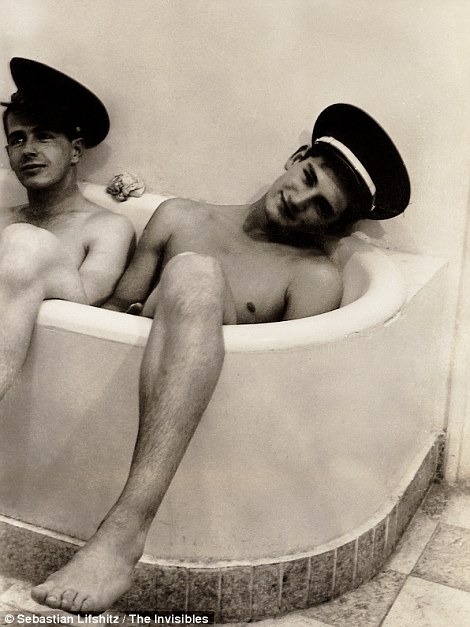Portraits of pride: Touching photographs reveal everyday life of gay couples in the early 20th Century - before the closet door opened
- French screenwriter Sébastien Lifshitz spent 20 years collecting photos from flea markets and garage sales
- They proudly portray alternative sexuality in the U.S. and Europe at a time when many had to hide their true feelings
- 'The need to keep a memory of their love was stronger than the disapproval of neighbourhood photo lab', he said
It seems ordinary enough - a photo album of couples exchanging everyday affection in their gardens, their kitchens, in bed and in the bath.
But what makes these images so touching is that the couples were almost certainly gay, at a time when to be so was illegal in many parts of the western world.
French screenwriter Sébastien Lifshitz took more than 20 years to amass his collection from flea markets and garage sales, where he became fascinated with the carefree happiness of people who were often outcasts in society.

Carefree: French screenwriter Sébastien Lifshitz spent more than 20 years collecting hundreds of photos from flea markets and garage sales which portrayed gay couples in their everyday lives - at a time when what they did behind closed doors was illegal. Mr Lifshitz said he was fascinated by their wealth of love and affection


Ambiguous: Because he never knew the couples himself, Mr Lifshitz could not be sure if they were gay, bisexual or transgender, or simply revelling in sexual freedom
Because he never knew the couples himself, he could not be sure if they were gay, bisexual or transgender, or simply revelling in sexual ambiguity and freedom.
Instead what interested him was their happy poses with one another. They are pictured dancing, play-fighting and looking playfully at their mystery photographers.
Mr Lifshitz said it was significant that in an age before digital photography, the couples would have to face the scrutiny of a neighbourhood processing lab.
'The need to keep a memory of their love was certainly stronger than the disapproval of some business, or any concerns about what others might say,' he said.
One photograph which particularly struck him was of a middle-class lesbian couple in the mid-20th Century.
'What astonished me was that their middle-class appearance didn’t match the act: the act of producing an image of homosexual love at a time when discretion was the norm,' he said.

Affectionate: The sitters are portrayed in domestic settings, at ease with one another and with their photographers, whose identities will forever be a mystery

Span: The photos span from around 1900 to around 1960. Homosexuality remained illegal in Britain until 1967, and was only declassified as an illness in the U.S. in 1973
'Because to obtain these images, they had to have gone to a small neighborhood photo lab to develop the film and then go back to pick up the prints. They, therefore, had to run the risk of exposing themselves socially.'
Gay couples had plenty of reasons to be discreet in the early 1900s. Homosexuality remained illegal in Britain until 1967, and was only declassified as a mental illness in the U.S. in 1973.
While there were pockets of acceptance - the raucous, sexually liberal nightclubs of early 1930s Berlin became the inspiration for the hit musical Cabaret - many were wiped out by the rise of fascism in Europe or social conservatism elsewhere.
All of the photos collected by Mr Lifshitz predate what he called the Stonewall Era, when the Stonewall riots in 1969 New York triggered a global movement towards acceptance, and the end of an era of 'shame and seclusion'.
While many of the images' origins are unknown, they are believed to be from the U.S. and countries in continental Europe including France, Portugal and Germany.


Documented: Mr Lifshitz revealed his collection in an award-winning film and the photos have been reprinted in a book, The Invisibles: Vintage Portraits of Love and Pride
As well as finding carefully assembled photo albums at flea markets, the screenwriter added to his collection by approaching specialist galleries and buying vintage photographs through Ebay.
Mr Lifshitz made a documentary about the photographs called The Invisibles, which was included at the Cannes Film Festival and won France's César Award the country's best documentary last year.
Now 250 of the images, which also portray exuberant cross-dressing and sexual ambiguity, have been collected in a book called The Invisibles: Portraits of Love and Pride.
THE INVISIBLES: VINTAGE PORTRAITS OF LOVE AND PRIDE by Sébastien Lifshitz is available from Rizzoli New York for £16.99.
Most watched News videos
- Scottish woman has temper tantrum at Nashville airport
- Tesla Cybertruck explodes in front of Trump hotel in Las Vegas
- Mass panic as New Orleans attacker flies down Bourbon street
- Shocking moment zookeeper is fatally mauled by lions in private zoo
- Horrific video shows aftermath of New Orleans truck 'attack'
- Meghan Markle celebrates new year in first Instagram video
- Tesla Cybertruck burns outside Trump hotel in Las Vegas
- See how truck that drove into crowd made it through police barrier
- Cheerful Melania Trump bops to YMCA at Mar-a-Lago NYE bash
- New Orleans terror attack suspect reveals background in video
- Plane passenger throws drink at flight attendant in boozy fight
- Horrifying moment yacht crashes into rocks and sinks off Mexico coast






























If the identities are unknown, how can one assume ...
by kristennikco 282